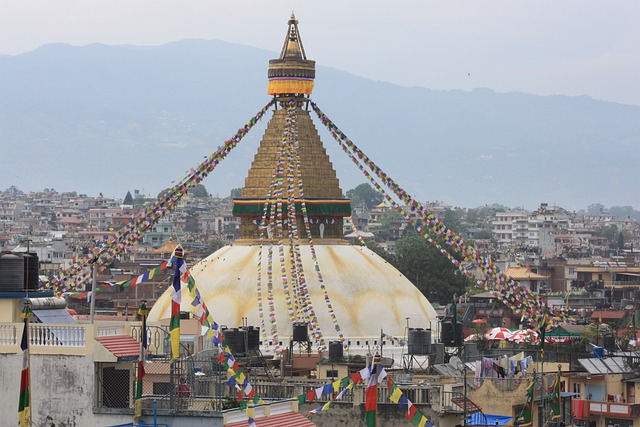Nepal is a landlocked country in South Asia. It is bordered by India to the east, China to the north and west and Tibet to the south. The capital of Nepal is Kathmandu.
The Himalayas form the backdrop to the city of Kathmandu, with Mount Everest being one of the highest peaks in the world.
Nepal is a landlocked country and is bordered by India to its east, China to its north and west and Tibet to its south. The capital of Nepal, Kathmandu, is located at an elevation of 2,600 meters (8,530 ft) above sea level. The Himalayas form the backdrop of the city, with Mount Everest being one the highest peaks in the world. There are many other mountains in Nepal that are higher than Mount Everest.

Nepal has a rich culture and history. It is known as the “Land of the Living Goddess”, the “Land of the Living Buddha”, and the “Land of the Golden Temple”. In the past, Nepal was ruled by the Mauryan dynasty, the Gupta dynasty, the Shahis, the Mallas, the Gorkhas and the Ranas.
Today, Nepal is a democracy with a parliamentary system of government. The Nepalese language is Nepali, which is a Tibeto-Burman language. The Nepalese people have a long history of independence from their neighbours.
Nepal is a country in South Asia, located in the Himalayas. It has been inhabited since prehistoric times, and it is home to many ethnic groups. The earliest evidence of human settlement in the country dates back to the Neolithic period (10,000 BC). The country was ruled by several kingdoms until 1816 when it became a British protectorate. In 2008, Nepal officially became a republic.
The history of Nepal can be divided into three main periods. The first one is from prehistoric times up to the 6th century AD. The second period begins with the arrival of the Gurkhas in the 18th century. Finally, the modern history of Nepal begins in 1846 with the British annexation.
Prehistoric Times
The oldest evidence of human settlement in Nepal is dated back to 10,000 BC. During this time, the area was inhabited by hunter-gatherers. There are several theories regarding the origin of these people. Some believe that they migrated from India, while others think that they came from the Middle East. They were farmers and lived in small villages. Their culture was very similar to the cultures of other hunter-gatherers of the same region.
The first signs of civilization appeared in the Terai region of Nepal. This region is located between the Ganges River and the Brahmaputra River. This is the only area in Nepal that still preserves some traces of its prehistoric past. In the Terai, the inhabitants lived in small villages surrounded by walls.
These settlements were called “palaces” or “fortresses”. The inhabitants of these palaces were called “Brahmans”. They were the most powerful people in the region. The Brahmins controlled trade and agriculture. They also had their own caste system. They were forbidden to marry outside the caste.
In the central region of Nepal, the inhabitants lived in small communities called “Vihars”. They were not organized in palaces. They had no caste system. They lived in large villages, which were often protected by fortifications.
The first urban settlements in Nepal were founded around 1000 BC. They were built near the banks of rivers. The inhabitants of these cities were traders. They used boats to transport goods to distant markets.
Migrations
Around 500 BC, the population of Nepal began to grow rapidly. The people were mostly farmers. They grew rice, barley, wheat, maize, millet, sorghum, and beans. They also raised cattle, sheep, goats, pigs, and water buffalo. They also hunted wild animals and fished in the nearby rivers. The population increased so much that the land could not support it anymore. This led to several migrations.
Some people moved to the central region of Nepal, where they settled in new villages. Other people moved to the eastern region, where they established new settlements.
In the 6th century AD, the population of Nepal started to decrease. The reasons for this decline are unknown. It is believed that the population decreased because of wars, epidemics, and famines.
Gurkha Empire
The first written evidence about Nepal dates back to the 1st century AD. At that time, the country was under the control of the Kushan Empire. The Kushan dynasty ruled over the Indian subcontinent for almost 200 years. The last Kushan king died in 165 AD. He was succeeded by his son Kanishka. The new king immediately declared himself emperor. He expanded his empire to the east and west.
The Kushan dynasty ended in the 2nd century AD. The country was divided into four provinces. The western part was ruled by the Maurya dynasty, while the eastern part was governed by the Gupta dynasty.
In the 4th century AD, the country was conquered by the Huns. They built several fortresses in the central and eastern parts of the country. They established their capital in Patna. The kingdom of Nepal was founded in the 8th century AD. The king of Nepal was called Devapala. He ruled the country until 1237 AD.
British Protectorate
During the 15th century, the country was ruled by the Mallas. The Mallas were Hindus who followed the religion of the Shaktas. The Mallas were defeated by the Gorkhas in 1415 AD.
After the defeat, the country was invaded by the Mongols. The Mongols destroyed the city of Patan and killed many inhabitants. In 1644 AD, the country was invaded by Shah Shuja. He was the son of Babur, the founder of the Mughal dynasty. The Mughals ruled the country for more than 150 years.
The British occupied the country in 1816. They established a protectorate over the country. In 1846, the country became a British protectorate.
Modern Times
The modern history of Nepal begins in 1860 AD. The Nepalese fought against the British for independence. They were supported by the Gurkhas. After a long war, the British gave up.
The country gained its independence in 2008. King Gyanendra was forced to abdicate by the Nepalese people. The new king, King Birendra, was chosen by the Constituent Assembly.
The history of the country is full of interesting facts. The country is rich in natural resources, such as gold, copper, and silver. It is also rich in historical monuments and cultural heritage. There are more than 30,000 temples in the country.

Leave a Reply